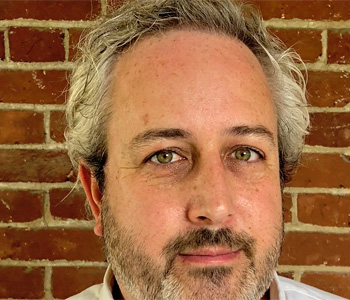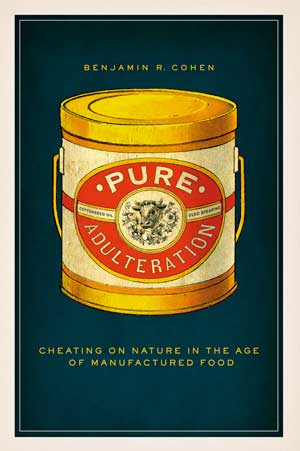
Pure Adulteration is about the origins of manufactured food. More centrally, it is about the struggles people had with the introduction of new foods in the later 1800s. The book follows the “pure food crusades” that raged between the 1860s and early 1900s as a window onto those forms of resistance and accommodation.
That era revealed confusing new tensions in the ways people understood, bought, trusted, and ate their food. Cultural factors help explain why anyone cared. They show that a prevailing suspicion of cheats, frauds, hucksters, and con men—and an associated fervor for sincerity, authenticity, and honesty—provided the foundation from which the era was born.
Environmental factors help explain how the prevailing cultural concerns made things worse. New supply chains, complex commodity flows, far-flung land-use patterns, and theretofore unknown ingredients all formed a new infrastructure of food and agriculture that made the view from farm to fork thick and opaque.
Together, that host of cultural and environmental conditions shaped the pure-food crusades and the set of chemists, analysts, and public health officials bent on commandeering and policing the concept of purity. The brunt of those collective changes led to this: whereas into the mid-nineteenth century it was still common to understand food purity based on its origins, its provenance, and its purveyors, by the early twentieth century the concept of purity had moved from its agricultural setting to be relocated into the hands of the analyst and lab. Purity had become a scientific concept policed by government agencies and backed by certified analysis. It would be the analysts and scientists who drew the line between pure and adulterated.
All of that suggests that a different way to give the “in a nutshell” answer is that Pure Adulteration is about how people changed the way they drew the line between pure and adulterated. There is (and was) no natural, pre-human distinction that we can simply uncover and enforce; we have to decide where to draw it and how to police it.
Today’s world is different from that of our nineteenth-century forbearers in so many ways, but the challenge of policing the difference between acceptable and unacceptable practices remains central to daily decisions about the foods we eat, how we produce them, and what choices we make when buying them.
I want readers to see how people made meaning about big key terms that we may otherwise take for granted: nature and artifice, authenticity and insincerity, purity and adulteration. Trust and confidence sit at the center of all of those terms—whether we trust people, why we do, what we trust them about, how we challenge those modes of trust and belief. I hope readers gain the view that modern, post-war worries over industrial food identity and health have their basis much earlier in century-old modes of producing, buying, and consuming food. If we want food reform today, we need to have a clearer understanding of the foundations of our manufactured, industrial food system.
I said there are two ways that “in a nutshell” the book is about how people understood, resisted, and accommodated the origins of manufactured food. But here we are at the next question and I’ll admit the fuller reality of the story is that it’s aimed at the difference between surfaces and interiors. Is appearance reality? Does the surface of a person or a product reflect its true substance? With new foods coming from factories and not just fields, with new packaging and processing, with new sources and more complex distribution networks, it was increasingly difficult to know the veracity of food. Adulteration has been around for millennia, it wasn’t new in the 19th century, but the combination of cultural (trusting people) and environmental challenges (trusting sources and processes) stepped up angst and governmental responses.
The history of science, and chemistry in particular, is threaded throughout the book, while taking center stage in the last part. People thought science and industry were the cause of but possibly the solution to worries over food health and identity.
Such questions about science and technology’s complicated political role followed from most of the work I’ve done over the past fifteen years. My first book, Notes from the Ground, had examined the cultural and environmental foundations of agricultural science in the early American Republic. That book ended in the 1860s with the arrival of the USDA, where the new sciences of agriculture helped promote new fertilizers and ways of working the land. Fertilizers were one of the first things to have labels on them, showing what you were getting if you bought it from a supplier instead of just applying it from your cows or other sources of soil amendments (like limestone, for example). When I went to find out how that worked—who was certifying these products, who was making them, where was there controversy—the story led me to a fuller exploration of foods rather than farms, of products rather than processes.
My professional path, then, brought me to fill in the rest of the nineteenth century. In so doing, I came to understand that the breadth and complexity of these pure food crusades were really about bigger issues of cultural angst amidst rapidly changing demographics and politics. In that story, science was meant to cut through surfaces to reveal the truth inside.
Most of the chapters begin with a story about a con man or a point of confusion and mistrust in the world of nineteenth century foods. The first chapter introduces a man known as the “greatest swindler of the age,” the second chapter begins with a guy I met who I’m still not sure was a huckster or not, the fourth starts with my own childhood confusion over food identity, the sixth opens with another con man, and the seventh has a story about a dairyman’s sleight of hand trying to trick judges at an agricultural fair. I’d thus encourage readers to jump into the opening of a chapter, any one.
If you really want to press me, I’ll admit that the core three chapters on the geography of adulteration took the most work and may offer the best examples of threading environment, culture, and industrialization together. I couldn’t say they are my favorites, because I like each chapter, but I will say the networks of new foods those chapters draw out—margarine, cottonseed oil, glucose—and the maps and commodity flows I was able to create with a team of students and digital humanities colleagues make it clear to readers that easy answers about adulteration and resistance to new foods (“it was just dubious businessmen!”; “it was because of stubborn resistance!”; “it was inevitable!”) are not compelling or helpful.
What I learned about this period in history was that there was a major shift in agricultural activity, ethics, and food identity in a busy half century: what had been an age-old mode of understanding food based on the process transformed by the early 20th century to one understood by attention to the product. Instead of the thick culture of agricultural activity, agrarian livelihoods, and the experiences of cultivating, processing, sharing, selling, and preparing food to eat—all about process and activity—government regulation, corporate marketing, and scientific analysis focused on the product at the end of the agricultural lifecycle.
This is especially apparent as codified in the Pure Food and Drug Act of 1906 and, then, the FDA that soon derived from it. That producer-to-consumer change became my main point of interest as I thought about current issues of food and agricultural ethics. Genetically modified organisms (GMOs), food additives, and continuing angst over contamination define the comparable worries of our twenty-first century.
For me, a study of the era of adulteration shows that debating the merits of food identity and safety at the end of the food life cycle—the consumer option at the store—gives up the majority of the work we call agricultural, ethical, and political. The book’s implications, and I say this outright in the epilogue, are that to argue over GMOs and chemical additives today requires more attention to the environmental circumstances producing them and the cultural values at play, not just the product resulting from those processes.


Benjamin Cohen is an associate professor at Lafayette College in Easton, PA. In addition to Pure Adulteration, he is the author of Notes from the Ground: Science, Soil, and Society in the American Countryside (2009) and co-editor of Technoscience and Environmental Justice: Expert Cultures in a Grassroots Movement (2011). Beyond those, he writes widely on the history of food, the environment, science, and technology.